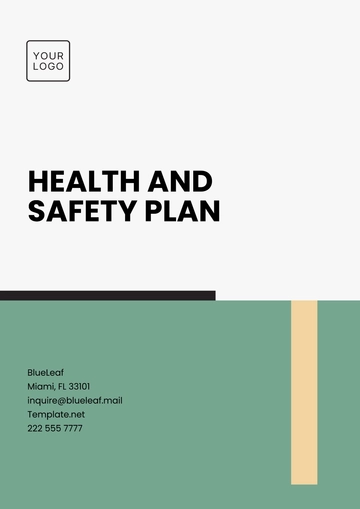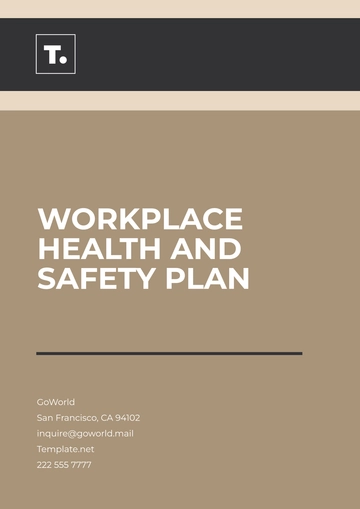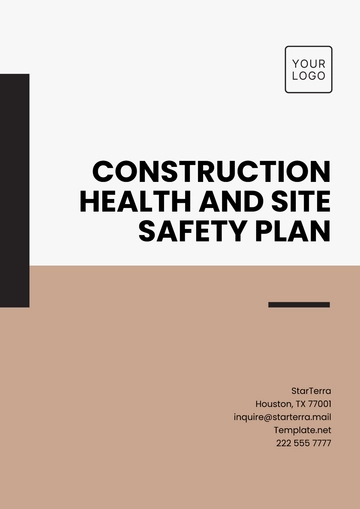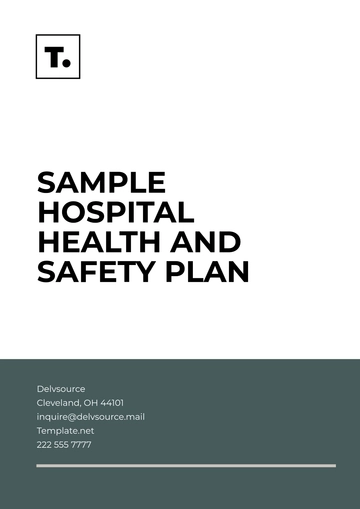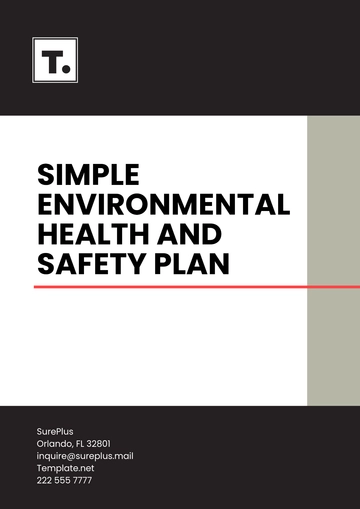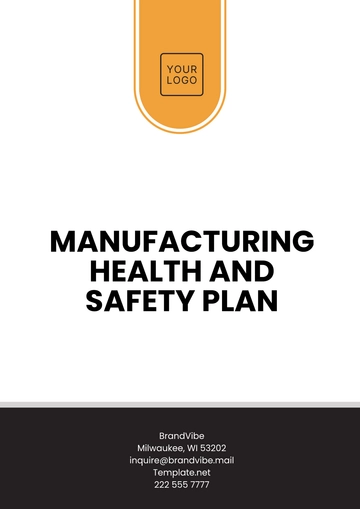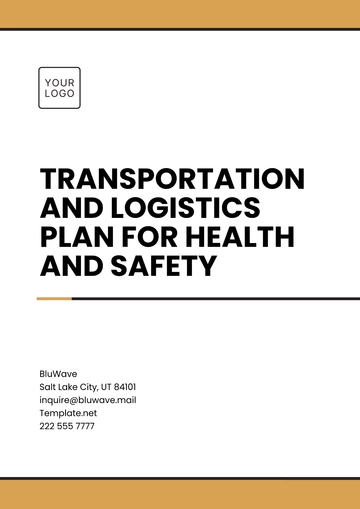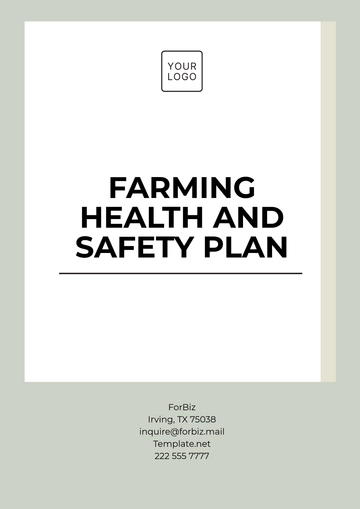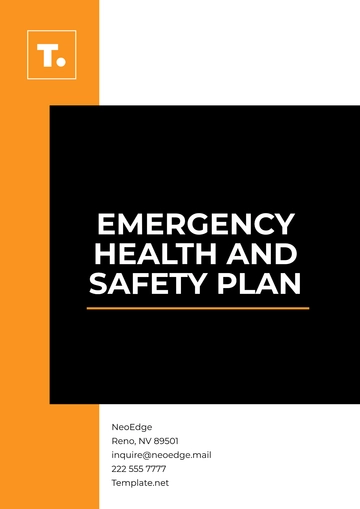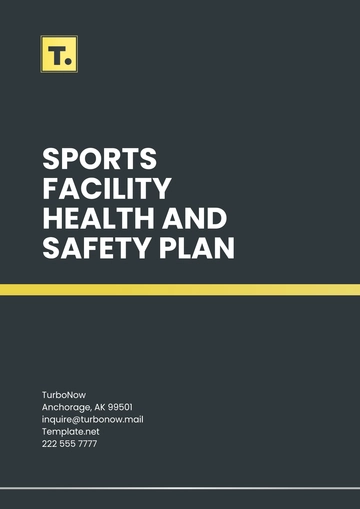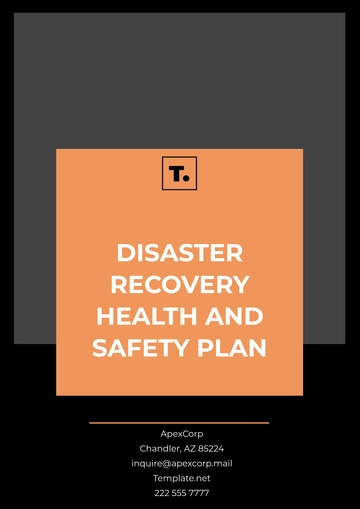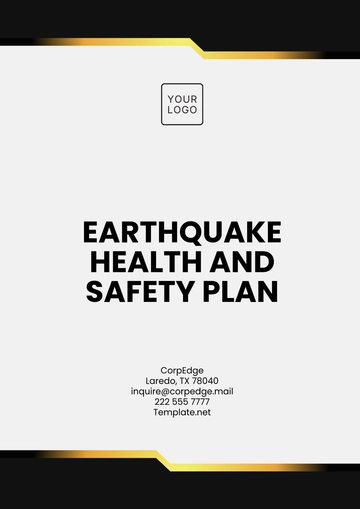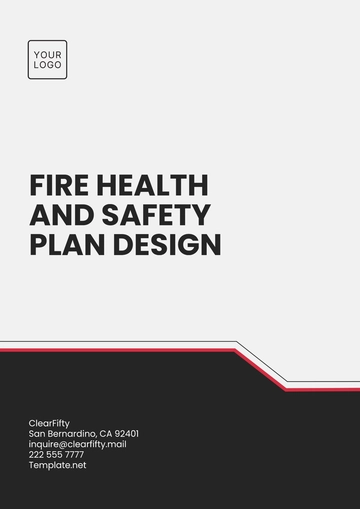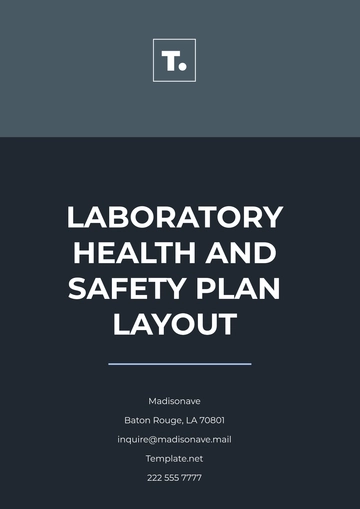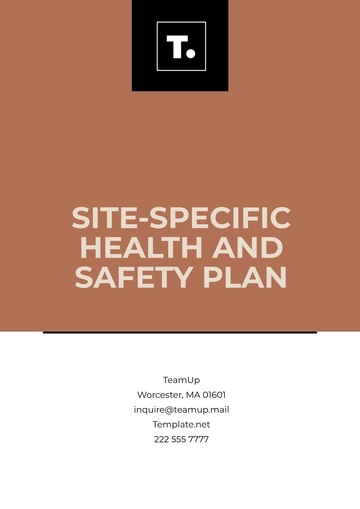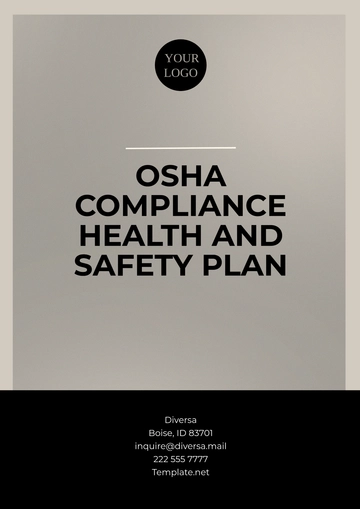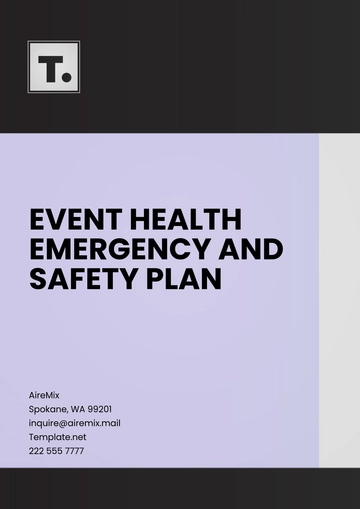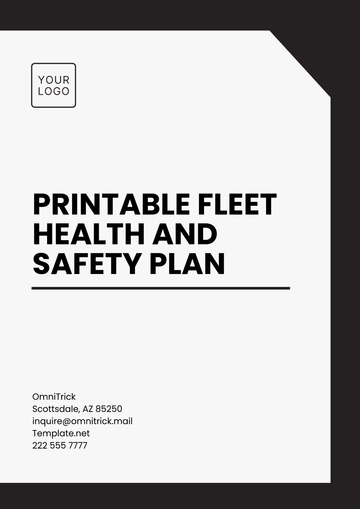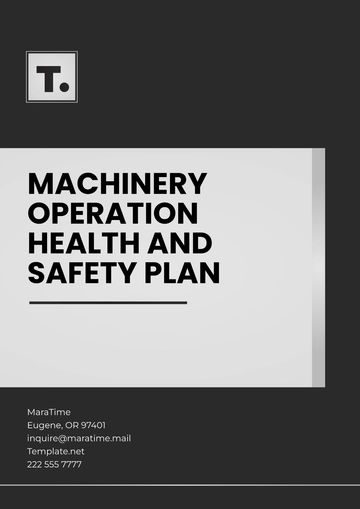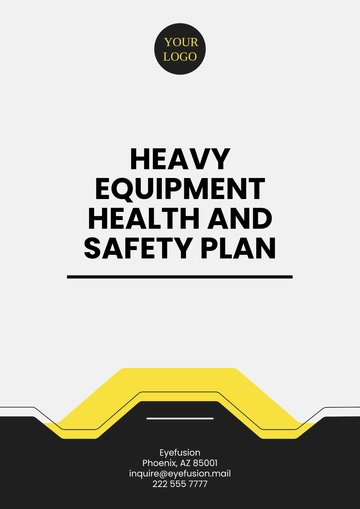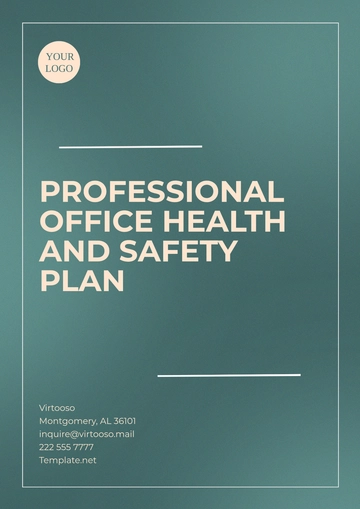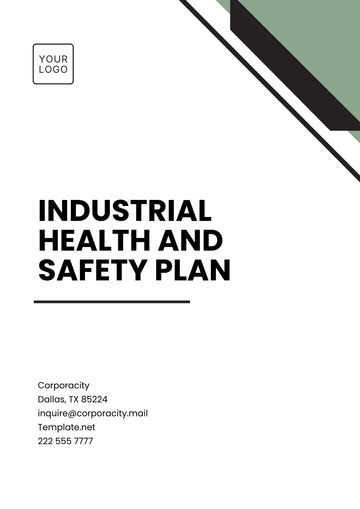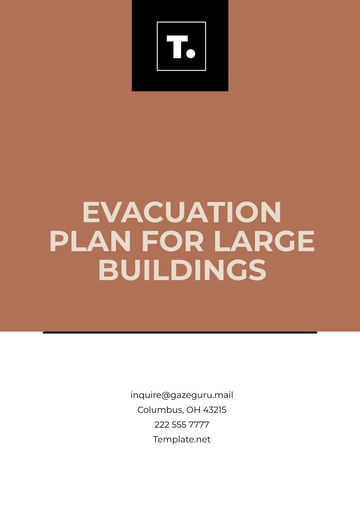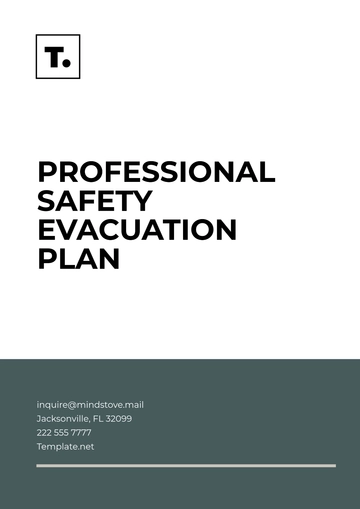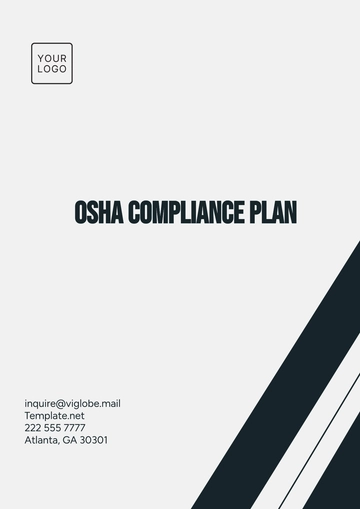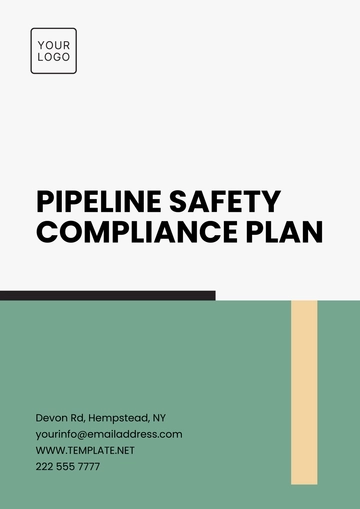Free Agriculture Safety Improvement Plan
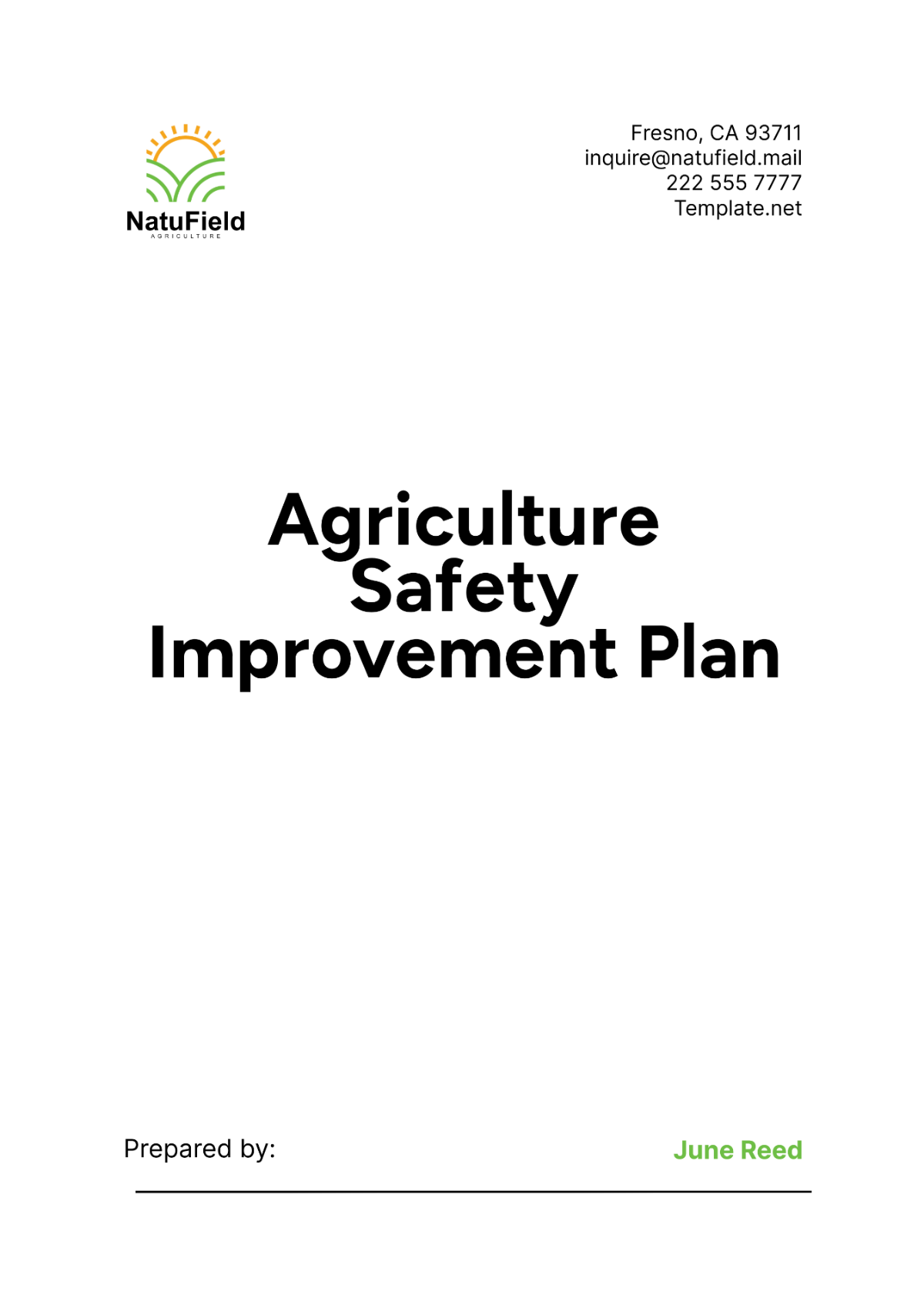
I. Executive Summary
This Agriculture Safety Improvement Plan of [Your Company Name] aims to enhance the safety protocols and practices within our operations. This comprehensive plan addresses key areas such as risk assessment, training, equipment safety, and emergency response. By implementing these strategies, we aim to reduce incidents, improve worker safety, and ensure compliance with industry regulations.
Our key goals include a 20% reduction in workplace accidents, a 15% increase in safety training participation, and the implementation of new safety equipment protocols. This plan sets a clear roadmap for achieving significant safety improvements, fostering a safer work environment, and enhancing the overall productivity and well-being of our workforce.
II. Risk Assessment
A. Hazard Identification
Machinery Hazards: Identifying potential hazards associated with operating machinery, including entanglement, crushing, and mechanical failure. Proper identification helps in mitigating risks through appropriate safety measures.
Chemical Hazards: Recognizing the risks posed by the use of pesticides, herbicides, and other chemicals. This identification ensures the implementation of safe handling and storage practices.
Ergonomic Hazards: Identifying ergonomic risks such as repetitive strain injuries and musculoskeletal disorders. Proper identification aids in developing ergonomic interventions.
Environmental Hazards: Identifying environmental risks including extreme weather conditions, and exposure to harmful UV radiation. Recognizing these hazards helps in planning preventive measures.
B. Risk Evaluation
Likelihood of Occurrence: Assessing the probability of identified hazards occurring within the workplace. This evaluation is crucial for prioritizing safety measures and resource allocation.
Severity of Impact: Evaluating the potential impact of hazards on workers' health and safety. Understanding the severity helps in implementing appropriate safety protocols.
Control Measures Effectiveness: Assessing the current control measures in place and their effectiveness in mitigating risks. Regular evaluation ensures the continuous improvement of safety protocols.
Documentation and Reporting: Maintaining thorough documentation and reporting of risk assessments. Proper documentation aids in tracking improvements and ensuring compliance with safety standards.
C. Risk Management Plan
The following table outlines the risk management plan:
No. | Risk Category | Control Measures |
|---|---|---|
1 | Machinery Hazards | Regular maintenance, safety guards, and training |
2 | Chemical Hazards | Proper storage, PPE, and safety data sheets |
3 | Ergonomic Hazards | Ergonomic tools, proper lifting techniques |
4 | Environmental Hazards | Protective clothing, shelter, hydration stations |
Machinery Hazards: Regular maintenance and the use of safety guards significantly reduce the risk of machinery-related accidents. Training workers on proper operation further enhances safety.
Chemical Hazards: Proper storage of chemicals and the use of personal protective equipment (PPE) minimize exposure risks. Safety data sheets provide essential information for safe handling.
Ergonomic Hazards: Implementing ergonomic tools and training workers on proper lifting techniques help prevent ergonomic-related injuries. These measures improve worker comfort and productivity.
Environmental Hazards: Providing protective clothing, shelter, and hydration stations helps mitigate the risks associated with environmental hazards. These measures ensure worker safety in extreme conditions.
Effective risk management requires ongoing evaluation and adaptation of safety measures. By addressing the identified hazards with appropriate control measures, we can create a safer work environment.
III. Training and Education
A. Safety Training Programs
General Safety Training: Comprehensive safety training for all employees covering basic safety principles, emergency procedures, and company policies. This foundational training ensures all workers understand safety expectations.
Equipment Operation Training: Specialized training for workers operating machinery and equipment. This training focuses on safe operation, maintenance, and emergency shutdown procedures.
Chemical Safety Training: Training for workers handling chemicals, covering safe handling practices, PPE usage, and spill response procedures. This training ensures proper chemical management and reduces exposure risks.
Ergonomics Training: Training on ergonomic practices, including proper lifting techniques and workstation setup. This training helps prevent musculoskeletal injuries and promotes worker health.
B. Training Schedule
The following table outlines the training schedule for the year:
No. | Training Program | Frequency |
|---|---|---|
1 | General Safety Training | Quarterly |
2 | Equipment Operation Training | Biannually |
3 | Chemical Safety Training | Annually |
4 | Ergonomics Training | Biannually |
General Safety Training: Conducted quarterly to reinforce safety principles and update employees on new policies. Regular training ensures ongoing awareness and compliance.
Equipment Operation Training: Held biannually to provide hands-on training and refreshers for machinery operators. Regular training helps maintain safe operation practices.
Chemical Safety Training: Conducted annually to ensure proper handling and storage of chemicals. Annual training keeps workers informed about safe practices and regulatory changes.
Ergonomics Training: Held biannually to promote ergonomic practices and prevent injuries. Regular training encourages a healthy work environment.
Continuous training and education are crucial for maintaining a safe workplace. By providing regular and comprehensive training programs, we ensure that all employees are equipped with the knowledge and skills to work safely.
IV. Equipment Safety
A. Equipment Maintenance
Regular Inspections: Conducting routine inspections of all equipment to identify and address potential issues before they lead to accidents. Regular inspections ensure equipment is in good working condition.
Preventive Maintenance: Implementing a preventive maintenance schedule to keep equipment in optimal condition and prevent breakdowns. Preventive maintenance reduces the likelihood of accidents and extends equipment lifespan.
Repair and Replacement: Promptly repairing or replacing damaged or faulty equipment to ensure safe operation. Addressing equipment issues immediately minimizes safety risks.
Maintenance Records: Keeping detailed records of all maintenance activities, including inspections, repairs, and replacements. Maintenance records provide a history of equipment care and help in planning future maintenance.
B. Safety Features
Safety Guards: Installing safety guards on machinery to protect workers from moving parts and other hazards. Safety guards are essential for preventing injuries during equipment operation.
Emergency Stop Mechanisms: Equipping machinery with emergency stop mechanisms that allow workers to quickly shut down equipment in case of an emergency. Emergency stop mechanisms enhance worker safety.
Lockout/Tagout Procedures: Implementing lockout/tagout procedures to ensure machinery is properly shut down and de-energized before maintenance. These procedures prevent accidental startup and protect maintenance workers.
Warning Signs and Labels: Placing clear warning signs and labels on equipment to inform workers of potential hazards. Warning signs and labels provide important safety information and promote awareness.
C. Equipment Safety Checklist
The following table outlines the equipment safety checklist:
No. | Safety Check | Description |
|---|---|---|
1 | Visual Inspection | Check for visible damage or wear |
2 | Operational Check | Test equipment functionality |
3 | Safety Guards Check | Ensure safety guards are in place |
4 | Emergency Stop Check | Test emergency stop mechanisms |
5 | Lockout/Tagout Check | Verify lockout/tagout compliance |
Visual Inspection: Checking equipment for visible damage or wear ensures that any issues are identified and addressed promptly. Regular visual inspections help maintain equipment safety.
Operational Check: Testing equipment functionality ensures that it operates correctly and safely. Regular operational checks help prevent malfunctions and accidents.
Safety Guards Check: Ensuring that safety guards are in place and functioning properly protects workers from moving parts and other hazards. Regular checks of safety guards are essential for safe equipment operation.
Emergency Stop Check: Testing emergency stop mechanisms ensures that workers can quickly shut down equipment in case of an emergency. Regular checks of emergency stop mechanisms enhance worker safety.
Lockout/Tagout Check: Verifying lockout/tagout compliance ensures that machinery is properly shut down and de-energized before maintenance. Regular checks of lockout/tagout procedures protect maintenance workers.
Maintaining equipment safety is crucial for preventing accidents and ensuring smooth operations. By implementing regular maintenance and safety checks, we ensure that all equipment is safe for use.
V. Personal Protective Equipment (PPE)
A. PPE Requirements
Head Protection: Providing hard hats to protect workers from head injuries caused by falling objects or impacts. Hard hats are essential for preventing serious head injuries.
Eye and Face Protection: Providing safety glasses and face shields to protect workers from flying debris, chemicals, and other hazards. Eye and face protection is crucial for preventing injuries.
Hearing Protection: Providing earplugs or earmuffs to protect workers from noise-induced hearing loss. Hearing protection is important in noisy environments.
Hand Protection: Providing gloves to protect workers from cuts, abrasions, and chemical exposure. Hand protection is essential for preventing hand injuries.
Foot Protection: Providing steel-toed boots to protect workers from foot injuries caused by heavy objects or equipment. Foot protection is important for preventing serious injuries.
B. PPE Training
Proper Use of PPE: Training workers on the proper use of PPE, including how to wear, adjust, and maintain it. Proper use of PPE ensures maximum protection.
PPE Maintenance: Training workers on how to properly clean and maintain their PPE to ensure its effectiveness. Proper maintenance of PPE extends its lifespan and ensures ongoing protection.
PPE Storage: Training workers on how to properly store their PPE to prevent damage and contamination. Proper storage of PPE ensures it is ready for use when needed.
PPE Inspection: Training workers on how to regularly inspect their PPE for damage or wear and how to report any issues. Regular inspections of PPE ensure that it is in good condition and provides adequate protection.
VI. Emergency Response
A. Emergency Procedures
Evacuation Plans: Developing and implementing clear evacuation plans for various emergency scenarios, including fires, chemical spills, and natural disasters. Evacuation plans ensure that all workers know how to safely exit the facility in an emergency.
Emergency Contacts: Establishing a list of emergency contacts, including local fire departments, hospitals, and emergency response teams. Emergency contacts ensure that help is readily available in case of an emergency.
First Aid Procedures: Implementing first aid procedures and training workers on how to administer basic first aid. First aid procedures ensure that injured workers receive immediate care.
Fire Safety Procedures: Developing fire safety procedures, including the use of fire extinguishers and evacuation routes. Fire safety procedures are crucial for preventing and responding to fires.
Chemical Spill Response: Implementing procedures for responding to chemical spills, including containment and cleanup. Chemical spill response procedures ensure that spills are managed safely and effectively.
B. Emergency Response Team
Team Formation: Forming an emergency response team composed of trained personnel responsible for coordinating emergency procedures. The team ensures that emergencies are managed efficiently and effectively.
Training and Drills: Conducting regular training and emergency drills for the response team to ensure they are prepared for various scenarios. Training and drills help the team respond quickly and effectively.
Communication Plan: Developing a communication plan to ensure clear and effective communication during emergencies. The plan includes communication channels, protocols, and responsibilities.
Resource Allocation: Allocating necessary resources, including first aid kits, fire extinguishers, and emergency supplies, to support the response team. Proper resource allocation ensures that the team is equipped to handle emergencies.
C. Emergency Response Plan
The following table outlines the emergency response plan:
No. | Emergency Type | Response Actions |
|---|---|---|
1 | Fire | Evacuate, use fire extinguishers |
2 | Chemical Spill | Contain, clean up, report |
3 | Natural Disaster | Evacuate, seek shelter |
4 | Medical Emergency | Administer first aid, call 911 |
5 | Equipment Failure | Shut down, repair, report |
Fire: In case of a fire, evacuate the area immediately and use fire extinguishers to control small fires if it is safe to do so. Evacuation and prompt action help prevent injuries and damage.
Chemical Spill: For chemical spills, contain the spill to prevent further spread, clean up the spill using appropriate procedures, and report the incident to supervisors. Proper response minimizes exposure and environmental impact.
Natural Disaster: During a natural disaster, evacuate the area if necessary and seek shelter in designated safe areas. Evacuation and seeking shelter protect workers from harm.
Medical Emergency: In a medical emergency, administer first aid to the injured person and call 911 for professional medical assistance. Immediate response ensures that the injured person receives timely care.
Equipment Failure: If equipment fails, shut it down immediately to prevent further damage or accidents, and report the failure to maintenance for repair. Prompt action minimizes safety risks and operational disruptions.
Having a well-defined emergency response plan is crucial for ensuring the safety and well-being of all workers. By preparing for various emergencies, we can respond effectively and minimize the impact of incidents.
VII. Health and Wellness Programs
A. Health Screenings
Regular Health Checkups: Providing regular health checkups for all employees to monitor their overall health and detect potential issues early. Regular checkups help maintain a healthy workforce.
Vaccination Programs: Offering vaccination programs to protect workers from preventable diseases. Vaccination programs enhance overall health and reduce the risk of outbreaks.
Occupational Health Assessments: Conducting occupational health assessments to identify and mitigate work-related health risks. These assessments help ensure a safe and healthy work environment.
Mental Health Support: Providing access to mental health support services, including counseling and stress management programs. Mental health support promotes well-being and reduces stress-related issues.
B. Wellness Initiatives
Fitness Programs: Implementing fitness programs to encourage physical activity and improve overall health. Fitness programs help reduce the risk of chronic diseases and enhance worker well-being.
Nutrition Programs: Offering nutrition programs and healthy meal options to promote healthy eating habits. Nutrition programs improve overall health and productivity.
Stress Management Workshops: Conducting stress management workshops to help workers cope with work-related stress. These workshops promote mental health and well-being.
Work-Life Balance Programs: Implementing programs to promote work-life balance, including flexible work schedules and family support initiatives. Work-life balance programs enhance job satisfaction and reduce burnout.
VIII. Continuous Improvement
A. Safety Audits
Regular Safety Audits Regular safety audits are conducted every six months to evaluate the effectiveness of our existing safety protocols and identify potential areas for improvement. These audits involve a thorough review of safety practices, equipment conditions, and emergency procedures to ensure that all safety measures are being followed and are effective.
Third-Party Inspections Engaging third-party inspectors provides an objective evaluation of our safety practices. These inspections, conducted annually, offer a fresh perspective on our safety measures and help identify issues that may be overlooked during internal audits.
Employee Feedback Gathering feedback from employees through surveys and suggestion boxes helps identify practical improvements for safety practices. Regularly reviewing this feedback allows us to address concerns directly and make adjustments to enhance workplace safety.
Incident Analysis Analyzing incidents and near-misses helps understand their root causes and prevent future occurrences. This analysis is performed after every incident to identify contributing factors and develop effective preventive measures.
B. Performance Metrics
These metrics provide clear indicators of how well we are meeting our safety goals and help identify areas for further improvement:
No. | Performance Metric | Current Status | Target Goal |
|---|---|---|---|
1 | Number of Incidents | 15 incidents/year | < 12 incidents/year |
2 | Near-Miss Reporting Rate | 30 reports/year | 40 reports/year |
3 | Training Participation Rate | 75% | 85% |
4 | Compliance with Safety Regulations | 90% | 100% |
5 | Safety Audit Scores | 85% | 90% |
Number of Incidents: The current number of incidents is 15 per year, with a target goal to reduce this number to fewer than 12 incidents per year. Achieving this goal requires ongoing improvement in safety practices.
Near-Miss Reporting Rate: With 30 near-miss reports per year and a target to increase this to 40 reports per year, our focus is on encouraging proactive reporting of near-misses to prevent future incidents.
Training Participation Rate: Currently at 75%, we aim to increase this rate to 85% to ensure that all employees receive essential safety training. Higher participation rates in training programs enhance overall safety.
Compliance with Safety Regulations: With a current compliance rate of 90%, we aim for 100% compliance with all safety regulations. Achieving full compliance is critical for meeting legal requirements and ensuring a safe work environment.
Safety Audit Scores: Our current safety audit score is 85%, with a goal to improve this score to 90%. Improving audit scores reflects better adherence to safety practices and standards.
Effective performance metrics are crucial for monitoring and improving our safety programs. By setting clear targets and regularly reviewing performance data, we can identify areas for improvement and take proactive steps to enhance our safety practices. Performance metrics also help in tracking progress towards our safety goals and ensuring that we meet industry standards.
IX. Conclusion and Next Steps
A. Conclusion
This Agriculture Safety Improvement Plan of [Your Company Name] outlines a comprehensive approach to enhancing safety across our operations. By focusing on key areas such as risk assessment, training, equipment safety, and emergency response, we aim to create a safer and more productive work environment for all employees. The plan's emphasis on continuous improvement and performance metrics ensures that our safety practices remain effective and up to date.
Through the implementation of this plan, we seek to achieve a significant reduction in workplace accidents, improve employee health and well-being, and ensure compliance with industry regulations. The strategies outlined in this plan will help us address current safety challenges and lay the foundation for ongoing safety improvements.
B. Next Steps
To move forward with the Improvement Plan, the following next steps are required:
Implement Risk Management Strategies: Begin executing the identified risk management strategies and ensure all safety measures are put into practice. This involves scheduling training sessions, conducting safety audits, and setting up PPE requirements.
Launch Training Programs: Roll out the scheduled training programs and ensure all employees participate. Monitor attendance and effectiveness of the training sessions to achieve our training goals.
Communicate Plan Details: Share the details of the Safety Improvement Plan with all employees and stakeholders. Effective communication ensures that everyone is aware of the safety objectives and their roles in achieving them.
By taking these steps, we will be able to implement the safety improvements outlined in the plan and work towards creating a safer work environment for everyone.
- 100% Customizable, free editor
- Access 1 Million+ Templates, photo’s & graphics
- Download or share as a template
- Click and replace photos, graphics, text, backgrounds
- Resize, crop, AI write & more
- Access advanced editor
Develop robust safety strategies with our Agriculture Safety Improvement Plan Template! Fully editable, it allows you to customize the content to your needs. Available on Template.net, the template includes customizable sections. The AI Editor Tool ensures quick and precise creation, providing a comprehensive improvement plan tailored to your agricultural company!
You may also like
- Finance Plan
- Construction Plan
- Sales Plan
- Development Plan
- Career Plan
- Budget Plan
- HR Plan
- Education Plan
- Transition Plan
- Work Plan
- Training Plan
- Communication Plan
- Operation Plan
- Health And Safety Plan
- Strategy Plan
- Professional Development Plan
- Advertising Plan
- Risk Management Plan
- Restaurant Plan
- School Plan
- Nursing Home Patient Care Plan
- Nursing Care Plan
- Plan Event
- Startup Plan
- Social Media Plan
- Staffing Plan
- Annual Plan
- Content Plan
- Payment Plan
- Implementation Plan
- Hotel Plan
- Workout Plan
- Accounting Plan
- Campaign Plan
- Essay Plan
- 30 60 90 Day Plan
- Research Plan
- Recruitment Plan
- 90 Day Plan
- Quarterly Plan
- Emergency Plan
- 5 Year Plan
- Gym Plan
- Personal Plan
- IT and Software Plan
- Treatment Plan
- Real Estate Plan
- Law Firm Plan
- Healthcare Plan
- Improvement Plan
- Media Plan
- 5 Year Business Plan
- Learning Plan
- Marketing Campaign Plan
- Travel Agency Plan
- Cleaning Services Plan
- Interior Design Plan
- Performance Plan
- PR Plan
- Birth Plan
- Life Plan
- SEO Plan
- Disaster Recovery Plan
- Continuity Plan
- Launch Plan
- Legal Plan
- Behavior Plan
- Performance Improvement Plan
- Salon Plan
- Security Plan
- Security Management Plan
- Employee Development Plan
- Quality Plan
- Service Improvement Plan
- Growth Plan
- Incident Response Plan
- Basketball Plan
- Emergency Action Plan
- Product Launch Plan
- Spa Plan
- Employee Training Plan
- Data Analysis Plan
- Employee Action Plan
- Territory Plan
- Audit Plan
- Classroom Plan
- Activity Plan
- Parenting Plan
- Care Plan
- Project Execution Plan
- Exercise Plan
- Internship Plan
- Software Development Plan
- Continuous Improvement Plan
- Leave Plan
- 90 Day Sales Plan
- Advertising Agency Plan
- Employee Transition Plan
- Smart Action Plan
- Workplace Safety Plan
- Behavior Change Plan
- Contingency Plan
- Continuity of Operations Plan
- Health Plan
- Quality Control Plan
- Self Plan
- Sports Development Plan
- Change Management Plan
- Ecommerce Plan
- Personal Financial Plan
- Process Improvement Plan
- 30-60-90 Day Sales Plan
- Crisis Management Plan
- Engagement Plan
- Execution Plan
- Pandemic Plan
- Quality Assurance Plan
- Service Continuity Plan
- Agile Project Plan
- Fundraising Plan
- Job Transition Plan
- Asset Maintenance Plan
- Maintenance Plan
- Software Test Plan
- Staff Training and Development Plan
- 3 Year Plan
- Brand Activation Plan
- Release Plan
- Resource Plan
- Risk Mitigation Plan
- Teacher Plan
- 30 60 90 Day Plan for New Manager
- Food Safety Plan
- Food Truck Plan
- Hiring Plan
- Quality Management Plan
- Wellness Plan
- Behavior Intervention Plan
- Bonus Plan
- Investment Plan
- Maternity Leave Plan
- Pandemic Response Plan
- Succession Planning
- Coaching Plan
- Configuration Management Plan
- Remote Work Plan
- Self Care Plan
- Teaching Plan
- 100-Day Plan
- HACCP Plan
- Student Plan
- Sustainability Plan
- 30 60 90 Day Plan for Interview
- Access Plan
- Site Specific Safety Plan
